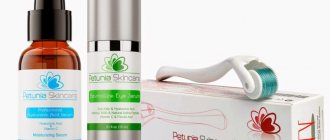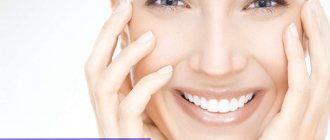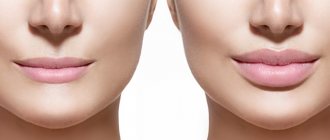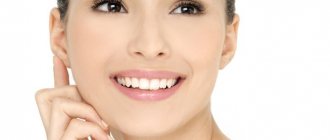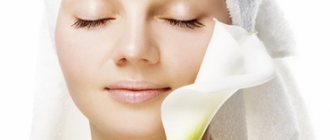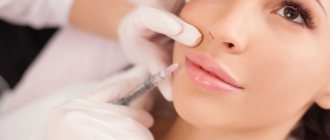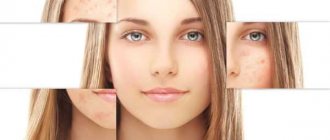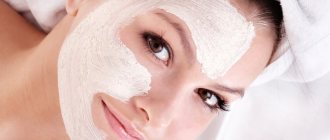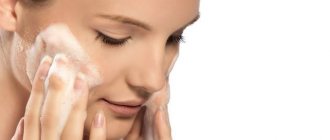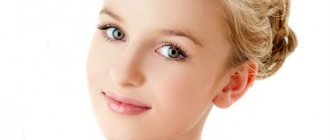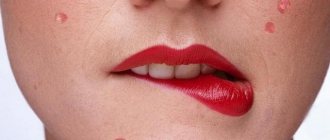- Indications
- Contraindications
- Peculiarities
- Kinds
- Stages
- Actions
- Side effects
- Rehabilitation
- Independent use
- pros
- conclusions
The cosmetology market offers various types of peelings for skin renewal. One of the most promising pharmaceutical agents is azelaic acid, which is included in many medications and, through chemical exfoliation, eliminates skin imperfections and initiates natural rejuvenation processes. The procedure has variations that are taken into account depending on the initial state of the epidermis and the expected results.
Benefits of azelaic acid for skin
- Has antibacterial and anti-inflammatory effects.
- Prevents the appearance of acne and sebaceous plugs.
- Reduces the risk of acne.
- Normalizes the production of subcutaneous fat.
- Whitens and evens out complexion.
Azelaine peeling can be prescribed for prevention, since this procedure not only treats, but also prevents the re-development of skin diseases.
The method of preparing the product yourself must be clarified with your treating cosmetologist - incorrectly selected proportions of various acids can lead to severe drying of the epidermis and burns.
Advantages compared to analogues
Azelaine peeling has advantages over other similar cosmetic procedures. It has a gentler effect on the skin, does not injure it, and also has a calming effect.
What are the positive aspects of azelaine peeling:
- no redness, irritation or itching after the procedure;
- no complications are observed;
- excludes the rehabilitation period;
- no addiction with frequent use;
- after the procedure, the sebaceous glands are not clogged, so the skin remains soft;
- Gently removes age spots on dark skin.
After azelaine peeling, a person can return to his business within a few hours. Additional deep moisturizing and treatment of the epidermis with emollients is not required, as after exposure to other acids.
Ready-made drugs
You can either prepare a peeling to cleanse the skin yourself or choose from a wide range of preparations that contain azelaic acid.
Mediderma
The company produces a line of products with azelaic acid, which helps fight acne, increased pigmentation and dermatological diseases, and also helps normalize the production of subcutaneous sebum.
Expert opinion
Anastasia Zaslavskaya
Dermatologist, cosmetologist
All of the proposed products can be used separately, but together they help achieve maximum effect.
Gigi
The drug is suitable for any type of epidermis, has a gel-like structure and, in addition to a complex of acids, contains olive oil and algae extracts.
Simildiet
The composition of this manufacturer's products includes 3% lactic, 2% salicylic and 20% azelaic acids. The product gently cleanses the skin of impurities and is recommended for use in the fight against comedones, acne and folliculitis.
Azelak
The company produces several cleaning products that differ in acid content:
- Azelac RU M. The composition includes 15% azelaic acid, 10% almond acid and 18% salicylic acid.
- Azelac RU. Contains 20% azelaic acid, 5% phytic acid, 2% ferulic acid and 10% almond acid.
- Azelac gel. Consists of 3.5% lactic acid and 20% azelaic acid.
The depth of cleansing depends on the chosen consistency and the number of layers applied.
The essence of the procedure
Products with azelaic acid affect the skin simultaneously in several directions:
- Deeply and gently cleanses. Penetrating deep into the epidermis, acid molecules dissolve the bonds between dead cells, stimulating their easy and rapid removal.
- Whitens skin. Azelain particles block the activity of melanocytes, which provoke melasma and other types of pathological hyperpigmentation. This helps even out the tone and prevent the appearance of age spots.
- Completely eliminates acne, rosacea, and other dermatological problems. Nonandioic acid has high bacteriostatic activity. It will be destructive for Propionibacterium acnes, Staphylococcus epidermidis. Regular use of the product helps reduce the number of problematic elements and reduce the risk of their occurrence after therapy.
- Refreshes, eliminates greasy shine. Acid particles stabilize the work and secretion of the sebaceous glands, help to establish self-cleaning of the mouths of the glands, prevent clogging of pores and the appearance of comedones.
- Restores the “breathing” of the skin, improves tone and elasticity of fibers, smoothes wrinkles and slows down the aging process. After azelaine peeling, the skin is more sensitive to active serums and nourishing creams. They quickly absorb beneficial components, thereby increasing the effectiveness of cosmetic products and improving the quality of the skin.
Cosmetologists recommend using azelaine peeling for rejuvenation only in combination with other cosmetic procedures. One cleansing can only give a superficial and short-lived effect of youth, freshness, nothing more. You can reinforce and enhance the achieved result with microdermabrasion, laser resurfacing, and deep acid peeling.
It is recommended that the procedure be performed by a highly qualified cosmetologist, although peeling at home is also possible. But keep in mind that home cleansing cannot guarantee the declared effect, plus it increases the risk of developing side effects and complications.
You can purchase an exfoliant in an online store, from your cosmetologist or in professional cosmetics stores. Don’t forget to pay attention to whether the seller has the appropriate documentation confirming the quality and originality of the product, and to make sure that the packaging is intact and that the expiration date has not expired.
Some girls take a big risk when purchasing concentrated azelaic acid at the pharmacy. Incorrect dilution proportions lead to burns, prolonged redness, and dry skin.
Note! Ready-made cosmetic products for peeling have a balanced composition and are supplemented with emollient additives, so the process of acid exposure is easier to control. But they are more difficult to buy (many manufacturers work only with cosmetologists), and the cost will be rather high.
Technology
Azelaine peeling is carried out in several successive stages:
- elimination of cosmetic residues and surface contaminants with an alcohol-free product;
- degreasing with glycolic acid will help open the pores as much as possible;
- treating the skin near the lips and eyes with a cream that contains ingredients that block the action of acids;
- distribution of peeling over the entire face, except for the eye and lip area;
- removing the cleanser after 7–10 minutes;
- applying an emollient cream to soothe damaged epidermis.
The procedure can be used on all skin types and is intended for superficial or medium peeling.
Preparation
Before the procedure, it is necessary to properly prepare the skin so that the result meets expectations and does not result in unpleasant consequences. Preparing for peeling includes several key steps, each of which must be taken very seriously.
- Before the procedure, you must consult with a specialist to find out the compatibility of the medications you are taking with azelaine peeling.
- The frequency of procedures and their duration must be planned.
- A week before the procedure, you should start applying gels containing AHA acids to your facial skin. This substance will prepare the dermis for the effects of azelaine.
- Two days before the procedure, it is necessary to test for allergic reactions. Apply a small amount of the drug to the skin and make sure that no negative changes occur.
Healing period
During the rehabilitation period you should:
- regularly moisturize the epidermis;
- treat your skin with sunscreen before going out;
- protect damaged skin from exposure to direct sunlight, wind and sudden temperature changes;
- Avoid visiting a solarium, open water, swimming pool or sauna for 2 weeks.
Compliance with these recommendations minimizes the risk of bacteria and other harmful microorganisms penetrating the skin. The average recovery time in the absence of complications is 14 days.
Side effects and complications
The first days after azelaine peeling, dryness of the epidermis, swelling, a feeling of tightness, redness and itching are observed - this is a normal reaction of the epidermis to chemical exposure.
During rehabilitation, an exacerbation of herpes, seborrhea or acne may occur, and pigmentation may also increase - most often the reason lies in non-compliance with the rules for preparing and performing the procedure.
To avoid negative consequences, before azelaine peeling you need to do an allergy test - for this, a small amount of the selected composition should be applied to the wrist and left for 15-20 minutes.
If during this time the skin becomes very red, a burning sensation or itching appears, the procedure should be abandoned.
Precautionary measures
Despite the delicacy of the effect and therapeutic effect, the exfoliation procedure has a number of limitations.
Contraindications
The main contraindications include:
- pregnancy;
- breastfeeding (lactation period);
- allergy to the components of the drug;
- inflammation of the integument, except for cases specified by the indications for cleaning;
- herpes in the active stage;
- fresh tan;
- open wounds, abrasions, damage to the skin in the treatment area.
The relative restriction for performing the procedure is age under 18 years. If indicated, the doctor, after a detailed analysis of the problem, may prescribe peeling for medicinal purposes.
Exfoliation is performed all year round, but do not forget about protection from sunlight even in cloudy weather.
Side effects and complications
Side effects are unusual for azelaine peeling. Violation of the protocol for preparing and carrying out the procedure, neglect of contraindications can provoke the following unpleasant phenomena:
- feeling of tightness, excessive dryness of the skin;
- enlarged pores;
- tissue swelling in the affected area;
- infection of the integument, exacerbation of acne, seborrhea;
- exacerbation of herpes;
- allergic reaction to the drug (rash, irritation, itching);
- persistent erythema;
- hyperpigmentation;
- increased skin sensitivity;
- formation of keloid scars.
The appearance of one of these phenomena should alert you and become a reason to contact a specialist. Self-medication can be harmful and make the problem worse. Only a cosmetologist prescribes appropriate treatment and corrects skin care.
Patient reviews
- Alexandra, 25 years old: “For several years I tried to get rid of freckles using various means - nothing helped. Recently, my friends gave me a certificate to visit a cosmetologist, I chose the course of azelaine peeling and was delighted! After 7 procedures, not only did all my freckles practically disappear, but my complexion evened out.”
- Svetlana, 29 years old: “I have quite oily skin and after 3 sessions I did not notice a visible transformation, so I completed the course. I can’t say anything bad either - my face became fresher and the oily sheen disappeared. The dermatologist said that I need a harsher scrub, so I will experiment further.”
- Margarita, 36 years old: “I saw changes in my neighbor after azelaine peeling and decided to try it on myself. As a result, red spots disappeared, acne decreased and the skin became more elastic. I completed a course of 5 procedures and have been enjoying the results for the second month now.”
Cost of the procedure in the salon
It is better to entrust any chemical peeling to professionals. Many years of experience in performing peelings, confident, quick and clear actions of the cosmetologist are the key points in achieving high results and problem-free recovery.
The price of peeling in different beauty salons, clinics, and medical centers can vary significantly. This is due to the brand and cost of the drugs and cosmetics used.
To a lesser extent, the price of the procedure is influenced by the rating and location of the clinic, the quality of the cosmetologist, and additional services. The estimated cost in Moscow is 2–3 thousand rubles per session.
Course duration
Depending on the initial condition of the skin, the concentration of the active component in the chosen product and the desired end result, the average course duration ranges from 5 to 10 procedures.
Between sessions you should take a break of 1-2 weeks. A repeat course can be taken no earlier than six months after the end of the recovery period.
Azelaine peeling will help you gently remove dead skin cells from the epidermis, get rid of rashes, rejuvenate and refresh your face - the main thing is to initially consult a specialist on the individual characteristics of the body.
Rating
Peeling effectiveness
Expecting an instant transformation and cure of problems on the face, many patients are very disappointed after the peeling. One procedure is not enough to solve the problems; course therapy is required.
The number of peelings is determined only by a cosmetologist after a detailed analysis of the condition of the skin. As a rule, these are 5–12 procedures, once every 1–1.5 weeks.
The effect of therapy lasts for about 6 months, after which the course is repeated. A significant advantage of azelaic acid is that it is not addictive, so it is suitable for long-term use.
After a course of acid exposure, you can expect the following changes:
- the greasy shine of the integument is replaced by a healthy glow;
- skin tone is evened out;
- the number of problematic, inflamed elements is significantly reduced;
- the face becomes clean, without blackheads;
- the skin becomes more elastic, elastic, tone and turgor increase;
- the face looks fresher, younger.

